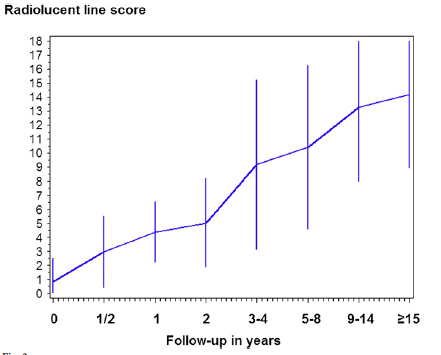These authors reviewed 45 total shoulder arthroplasties were performed in 40 patients using the Tornier Aequalis Shoulder (the procedure) performed between 1991 and 1995 for the diagnosis of glenohumeral osteoarthritis (the problem) by an individual surgeon (the physician).
While the clinical parameters improved from baseline until the latest follow-up evaluation, the results beyond 15 years were worse than the outcomes at the six-month follow-up examination.
The glenoid radiolucency increased progressively with time.
Thirty-three (73%) of the forty-five shoulders had radiographic evidence of glenoid loosening at the time of final follow-up. Fourteen shoulders (31%) were revised: a soft-tissue revision was performed in one of them, and implant revision was necessary in thirteen because of glenoid component loosening. These revisions were performed at an average of 9 years (range 3-16) after the index procedure.
The revision-free survival rates as a function of time are shown below:
The annualized revision rate is approximately 1.5% (compare this to that shown in the previous post).
Comment: This is a series of one of the most experienced shoulder arthroplasty surgeons in the world. We can only wonder what the revision rates would be for less experienced surgeons.
This paper confirms again that the glenoid component is the 'weak link' of total shoulder arthroplasty. While there have been changes in component design and in surgical technique, it is unknown if these will improve the long term outcomes.
The authors said it perfectly in their conclusion: " although there was a significant and longitudinal improvement in shoulder function and pain relief after total shoulder replacement, long-term follow-up of fifteen to twenty years demonstrated a high revision rate in this cohort, which could be related to the learning curve, implant design, and surgical technique. Although there have been subsequent changes in implant design and surgical technique, patients should be informed preoperatively in detail about the possible high rate of radiographic glenoid loosening and potential need for revision surgery. This study shows the importance of longitudinal observations and that it is crucial to follow patients over a long period in order to recognize late complications especially with new implant designs."
To learn more about shoulder arthritis and what can be done about it, see the Shoulder Arthritis Book.
To learn more about the rotator cuff, see the Rotator Cuff Book
Consultation for those who live a distance away from Seattle.
Use the "Search" box to the right to find other topics of interest to you.
You may be interested in some of our most visited web pages including:shoulder arthritis, total shoulder, ream and run, reverse total shoulder, CTA arthroplasty, and rotator cuff surgery as well as the 'ream and run essentials'
See from which cities our patients come.
See the countries from which our readers come on this post.
You may be interested in some of our most visited web pages including:shoulder arthritis, total shoulder, ream and run, reverse total shoulder, CTA arthroplasty, and rotator cuff surgery as well as the 'ream and run essentials'
See from which cities our patients come.
See the countries from which our readers come on this post.


